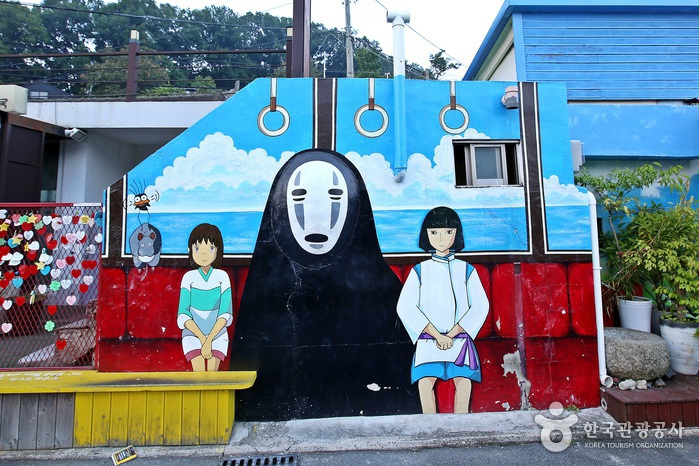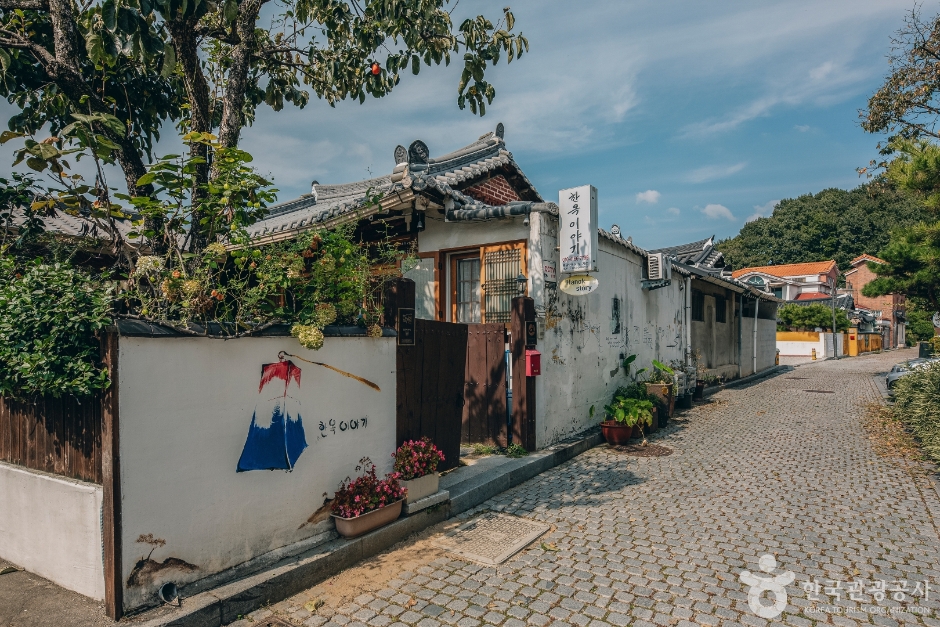Jaman Mural Village (자만벽화마을)
374.1M 1664 2024-04-07
1-10, Jamandong 1-gil, Wansan-gu, Jeonju-si, Jeonbuk-do
Jaman Mural Village is located in the ridge between Omokdae and Imokdae along the foot of Seungamsan Mountain’s Jungbawi Rock. Jeonju Hanok Village is also visible from the wide street. Although it is a fairly steep walk up to Jaman Village, visitors will be able to enjoy colorful murals painted on the buildings and walls along the way.
Jaman Mural Village (자만마을 벽화갤러리)
374.2M 1 2024-05-02
Gyo-dong, Wansan-gu, Jeonju-si, Jeonbuk-do
Jaman Mural Village is located on a hillside across the road from Jeonju Hanok Village. The village was formed by Korean war refugees resettling where they could, and remained as a small village interlaced by narrow pathways until 2012. At that point, the village was enlivened with over 40 murals and became popular for photographs. Many of the houses have been converted into cafes, guesthouses, and restaurants.
Royal Portrait Museum (어진박물관)
380.8M 19472 2024-04-07
44, Taejo-ro, Wansan-gu, Jeonju-si, Jeonbuk-do
+82- 63-231-0090
Opened on November 6, 2010, the Royal Portrait Museum is one of the newest attractions of Jeonju, located within the Gyeonggijeon Shrine. Royal Portrait Museum is a valuable museum as a new tourism resource of Jeonju as well as Gyeonggijeon Shrine and the Portrait of King Taejo, as well as other various high-class exhibitions to preserve, manage, and enhance the glorious cultural assets of Joseon royal family. The museum is comprised of one above-ground level and one underground level with an area of 1,193.71 square meters. The Portrait of King Taejo and six other king’s portraits (Portrait of King Sejong, King Yeongjo, King Jeongjo, King Cheoljong, King Gojong, and King Sunjong) are exhibited on the first floor. The portraits are preserved in temperature- and humidity-controlled cases. In addition, the museum houses History Hall, Palanquin Hall, a planned exhibition hall, resting area, management office and storage room for relics. Palanquin Hall exhibits Hyangjeong (Palanquin for Incense Burner and Case), Sinyeon (Palanquin for Royal Portrait and Palanquin for Mortuary Tablet), Chaeyeo (Palanquin for High Officials), Gagyo (Palanquin for Ritual Items) featuring Korea’s sole preserved palanquin. History Hall houses approximately 80 relices related to Gyeonggijeon Shrine and Jogyeong Shrine, ancestral ritual ceremony, building, and others relics. Since the museum's opening, it makes continual efforts to become a central place for Jeonju residents to fulfill their cultural feelings. The museum operates various program like exploring famous historic sites in Gyeonggijeon Shrine, hands-on programs such as a guard experience to protect the shrine, and duplicating Gyeonggijeon Shrine’s relics using traditional portrait-making techniques.
Hanokstory (한옥이야기)
383.8M 4018 2024-08-05
83-14 , Eunhaeng-ro, Wansan-gu, Jeonju-si, Jeonbuk-do
+82-10-9203-1111, +82-10-4166-7799
Hanok Story, on Hyanggyo-gil in Jeonju Hanok Village, Jeollabuk-do, is a hanok guesthouse that harmonizes tradition with convenience. Each room is equipped with a toilet, TV and AC, and one room has cooking facilities. In the yard is a 50-year-old persimmon tree - the house’s tutelary spirit - and a cafeteria built of cypress wood. Here visitors can enjoy tea or a free breakfast, while at weekends tea ceremonies are held (but book ahead for this).
Jeonjuhyanggyo Local Confucian School (전주향교)
408.1M 30148 2024-05-28
139 Hyanggyo-gil, Wansan-gu, Jeonju-si, Jeonbuk-do
+82-63-288-4548
Jeonjuhyanggyo is a local Confucian school that was established during the Joseon dynasty (1392-1910) and is a designated Historic Treasure. This was a national education center during the Joseon period. The school was originally located at the Gyeonggijeon Shrine site, but was relocated in 1603. The mortuary tablets of seven Chinese Confucian scholars and 18 Korean scholars are enshrined in the main building of Daeseongjeon Hall.
Fine day [Korea Quality] / 좋은날 [한국관광 품질인증]
418.4M 7982 2024-04-07
37-7 , Jeondongseongdang-gil, Wansan-gu, Jeonju-si, Jeonbuk-do
+82-10-2607-3326
A Fine Day is a hanok stay on Jeondong Cathedral Street, Jeonju, Jeollabuk-do, which combines hanok tradition with modern convenience. The wood floor and red clay-lined walls and ceilings are a pleasure to wake up to. The rooms are well heated and have toilets, shower booths and bidets. From the wooden porch guests can enjoy a beautiful sunny garden planted with wildflowers and trees. Nearby attractions include Gyeonggijeon, Omokdae, Jeondong Cathedral and Nambu Market (great for food!).
Goyu [Korea Quality] / 고유 [한국관광 품질인증]
423.8M 101 2024-04-07
51-5 , Hyanggyo-gil, Wansan-gu, Jeonju-si, Jeonbuk-do
+82-63-284-2588, +82-10-3682-5333
Goyu in Jeonju Hanok Village, is a hanok guesthouse that incorporates a cafe. It offers 5 guestrooms with exposed beams, hanji-covered floors, white cotton blankets and cotton curtains - the simple charms of a hanok! Each room has a bathroom, and beds are placed only in the room named“sweet sleep". Free coffee is provided to guests, and an English-language guide service is available if needed. Nearby tourist attractions include Jeonjuhyanggyo Confucian school, Gyeonggijeon Shrine, and Omokdae Pavilion.
Hakindang (학인당)
456.2M 12809 2024-08-05
45 , Hyanggyo-gil, Wansan-gu, Jeonju-si, Jeonbuk-do
+82-63-284-9929
Hagindang - also known as Injae’s Old House - is the oldest house in Jeonju Hanok Village, and a designated Jeollabuk-do cultural treasure. The house was built in the royal architecture style by some of the best late Joseon artisans. The Sarangchae guestroom has two sleeping rooms and a living room, suitable for families; while the Byeoldangchae has three guestrooms, one with a tea room space. Guests can use the free minibar while contemplating the old house’s fine traditional garden.
Kakao Friends - Jeonju Hanok Village Branch [Tax Refund Shop] (카카오프렌즈 전주한옥마을)
471.7M 1 2024-04-19
1F, 126, Paldal-ro, Wansan-gu, Jeonju-si, Jeollabuk-do
-
Jeonju Jeondong Catholic Cathedral (전주전동성당)
476.6M 52001 2024-05-27
51 Taejo-ro, Wansan-gu, Jeonju-si, Jeonbuk-do
Jeondong Catholic Cathedral in Jeonju was built in honor of Roman Catholic martyrs of the Joseon dynasty on the very same spot the martyrs lost their lives. The land was purchased by French Priest Baudenet in 1891 (28th year of King Gojong), but construction of the church did not begin until 1908. Construction was completed in 1914, a time during which Korea was under Japanese rule. Though originally built just outside of Pungnammun Gate, the site of the martyrs, the church was later moved to its current location for expansion.
The first Romanesque building in the Honam region, Jeondong Catholic Cathedral is made of gray and red bricks and bears a striking resemblance to the Myeongdong Cathedral in Seoul, also designed by Priest Poinel. Not only considered one of the most beautiful Catholic churches in Korea, some even go so far as to say it is one of the most beautiful structures in all of Korea, citing the church’s unique combination of Byzantine and Romanesque architectural styles. The rectangular building is topped with three Byzantine bell towers (to the right, center, and left) and boasts arched ceilings, several of which meet in the form of a cross.
It is interesting to note that some of the bricks used in construction of the church were made using materials from the Jeonjueupseong Walled Town, which was torn down by the Japanese. It is also said that the cornerstone of the church came from a wall of Jeonjueupseong Walled Town near Pungnammun Gate.




![Fine day [Korea Quality] / 좋은날 [한국관광 품질인증]](http://tong.visitkorea.or.kr/cms/resource/89/2597389_image2_1.jpg)
![Goyu [Korea Quality] / 고유 [한국관광 품질인증]](http://tong.visitkorea.or.kr/cms/resource/97/2651897_image2_1.jpg)

 English
English
 한국어
한국어 日本語
日本語 中文(简体)
中文(简体) Deutsch
Deutsch Français
Français Español
Español Русский
Русский